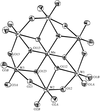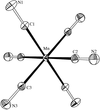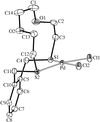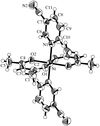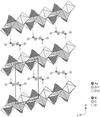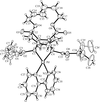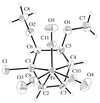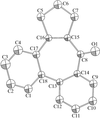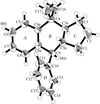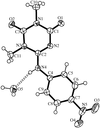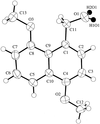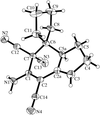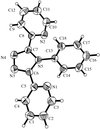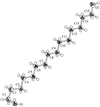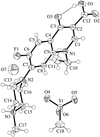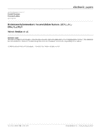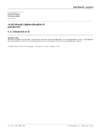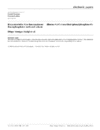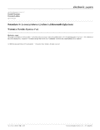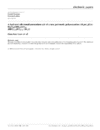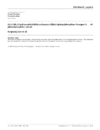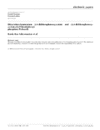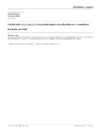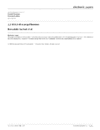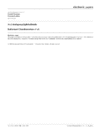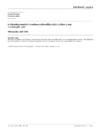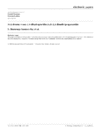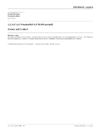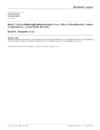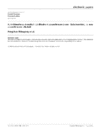issue contents
July 2000 issue

Cover illustration: View of (cis-6,13-dimethyl-1,4,8,11-tetraazacyclotetradecane-6,13-diamine-![[kappa]](/logos/entities/kappa_rmgif.gif) 6N)nickel(II) diperchlorate, with ellipsoids at the 30% probability level. The perchlorate anions are not shown. See Bernhardt [Acta Cryst. C56, 744-746].
6N)nickel(II) diperchlorate, with ellipsoids at the 30% probability level. The perchlorate anions are not shown. See Bernhardt [Acta Cryst. C56, 744-746].
inorganic compounds
Download citation


Download citation


The single-crystal structure of the title compound shows the anion to have the Anderson structure based on six WO6 octahedral edge-sharing units surrounding a central MnO6 octahedron. Varying interactions from the O atoms of the MnO6 octahedron to surrounding water molecules result in differences in the Mn—O distances.
Download citation


Download citation


Precise X-ray structural determinations of two Cr3+ α-alums are presented, each at 293 and at 12 K.
Download citation


Download citation


Precise X-ray structural determinations of Cs2K[Mn(CN)6] at 293, 85 and 10 K have been performed. The centrosymmetric [Mn(CN)6]3− anion has very close to regular octahedral stereochemistry.
Download citation


Download citation


The structure of dipotassium titanium trisilicate hydrate has been refined and the hydrogen-bonding geometry elucidated. The structure is a three-dimensional mixed framework with channels formed by six- and eight-membered rings. K+ ions and water molecules are located in the channels.
Download citation


Download citation


The title structure contains typical centrosymmetric OV6 double octahedra and centrosymmetric pairs of edge-shared NaO6 double octahedra forming a layered structure.
metal-organic compounds
Download citation


Download citation


Download citation


Download citation


Download citation


Download citation


Download citation


Download citation


Download citation


Download citation


Download citation


Download citation


Download citation


Download citation


Download citation


Download citation


Download citation


Download citation


Download citation


Download citation


Download citation


Download citation


Download citation


Download citation


Download citation


Download citation


Download citation


Download citation


Download citation


Download citation


Download citation


Download citation


Download citation


Download citation


This new organic zincoarsenate is built up from a two-dimensional framework of ZnO5 and ZnO6 polyhedra, and AsO4 tetrahedra. Trigonally coordinated O atoms are present in these layers. The organic cations are inserted between the inorganic sheets.
Download citation


Download citation


Download citation


Download citation


Download citation


Download citation


Download citation


Download citation


Download citation


Download citation


Download citation


Download citation


Download citation


Download citation


Download citation


Download citation


Download citation


Download citation


Download citation


Download citation


Download citation


Download citation


organic compounds
Download citation


Download citation


Download citation


Download citation


Download citation


Download citation


Download citation


Download citation


Download citation


Download citation


Download citation


Download citation


Download citation


Download citation


Download citation


Download citation


Download citation


Download citation


Download citation


Download citation


Download citation


Download citation


Download citation


Download citation


Download citation


Download citation


Download citation


Download citation


Download citation


Download citation


Download citation


Download citation


Download citation


Download citation


Download citation


Download citation


Download citation


Download citation


Download citation


Download citation


Download citation


Download citation


Download citation


Download citation


Download citation


Download citation


Download citation


Download citation


Download citation


Download citation


Download citation


Download citation


Download citation


Download citation


Download citation


Download citation


Download citation


Download citation


Download citation


Download citation


Download citation


Download citation


Download citation


Download citation


Download citation


Download citation


Download citation


Download citation


Download citation


Download citation


electronic papers (metal-organic compounds)
Download citation


Download citation


The crystal and molecular structure of the title compound shows that the polyoxoanion [Mo6O19]2− is built up from six distorted MoO6 octahedra sharing common edges and one common vertex at the central O atom, and has crystallographic m3m (Oh) symmetry. The cation has crystallographic  3m symmetry.
3m symmetry.
Download citation


Download citation


In the title compound, the PdII centre shows slightly distorted square-planar geometry, with the two chloro ligands in cis positions.
Download citation


Download citation


The Ru atom in the title complex shows an octahedral coordination and a trans arrangement of the triphenylphosphine groups. Both acetonitrile molecules are in the same plane as the o-benzoquinone diimine ligand. Bond distances for the benzoquinone diimine ring establish a quinone arrangement.
Download citation


Download citation


Schiff bases show a tautomeric equilibrium between the enol–imine and keto–amine forms. The title compound has bond distances which are in agreement with a keto–amine tautomer arrangement.
Download citation


Download citation


The polyanion of the title compound contains four PO4 tetrahedra and three VO5 square pyramids that are linked through corner-sharing by alternating P—O—V which gives rise to a chain. The chains, connected by CoO4(H2O)2 octahedra, form layers, resulting in a two-dimensional layered structure.
Download citation


Download citation


In the title compound, the Ni atom of the cation lies on an inversion centre and the Ni coordination is necessarily planar. The Ni—P distances are 2.2188 (5) and 2.2322 (5) Å, and the P—Ni—P angle is 73.12 (3)°. The unique perchlorate anion is not coordinated to the Ni atom.
Download citation


Download citation


The copper ion is in a distorted tetrahedral coordination, with two P atoms and two S atoms occupying the vertices. The longer Cu—S bond lies adjacent to the shorter C—S bond. The small S—Cu—S bond angle is due to the restricted bite angle of the ligand. The crystal structure has alternate layers of complex and triphenylphosphine molecules parallel to the bc plane.
Download citation


Download citation


The title compound consists of discrete [SnCl(CH3)2{N(C2H5)2}]2 dimers, with Sn atoms linked by bridging diethylamido groups. The coordination geometry about the metal atom is distorted trigonal bipyramidal, with the two methyl C atoms and one N atom in the equatorial plane, and the Cl and second N atom in axial positions.
Download citation


Download citation


The monoclinic cell of dicyclohexylammonium 2,4-dichlorophenoxyacetate contains four C12H24N+·C5H8Cl2O3− ion pairs. The ammonium N atom is hydrogen bonded to the oxygen ends of two carboxyl groups to form a 12-membered O—C—O⋯HNH⋯O—C—O⋯HNH ring. In (2,4-dichlorophenoxylacetato)bis(triphenylphosphine)silver(I) (shown opposite), the carboxyl CO2 unit chelates to the Ag atom in an anisobidentate manner [Ag—O = 2.436 (2) and 2.517 (2) Å]; the Ag atom shows distorted tetrahedral geometry.
electronic papers (organic compounds)
Download citation


Download citation


The absolute configuration of C4b (S) and C8a (R) was established with respect to the known C1 configuration (R). The compound forms infinite chains of hydrogen-bonded molecules.
Download citation


Download citation


The title compound is a dimer of fluorene investigated as part of study of materials for optoelectronic applications. The rings in the molecule are coplanar and the alkyl chains are perpendicular to this plane. The two fluorene moieties are head-to-foot and are related by a crystallographic centre of inversion.
Download citation


Download citation


In the molecule of the title compound, the phthalimide group is not exactly planar. The dihedral angle between the mean planes of the phthalimide and iodopropyl moieties is 76.6 (2)°. The structure is stabilized by intermolecular C—H⋯O and C—H⋯I interactions, and an intermolecular I⋯O interaction of 3.571 (4) Å, the latter linking the molecules into infinite chains.
Download citation


Download citation


The title compound, prepared by a standard synthetic method, has a cyclopropane ring fused to a cyclopentene ring. Comparison of the unit-cell dimensions and space group of this material with those of a crystal of the same material prepared using a route involving pig liver esterase hydrolysis shows them to be identical.
Download citation


Download citation


The rings in the pterin moiety are planar and the carbonyl O atom is in a synperiplanar conformation. N—H⋯N and N—H⋯O intermolecular hydrogen bonds form eight-membered rings with a graph-set motif of R22(8) on each side of the molecules, extending into infinite chains.
Download citation


Download citation


Bipyranyls and pyrylium salts are used for photochemical redox reactions. The pyran ring of the title molecule is not planar; the O atom lies very significantly out of the least-squares plane.
Download citation


Download citation


In the title compound, the phosphonoacetate carbonyl is rotated slightly out of the plane of the ureido ring, with a C—N—C—O torsion angle of −6.9 (4)°.
Download citation


Download citation


In the title compound, cyclohexane rings A and B are in the sofa conformation, ring C is in a chair conformation and the five-membered ring D is in an envelope conformation. The structure is stabilized by inter- and intramolecular C—H⋯O and O—H⋯O hydrogen bonds.
Download citation


Download citation


A new azaanthracene alkaloid (kalasinamide) has been isolated from the stems of Polyathia suberosa collected in the northeastern part of Thailand and its structure has been determined.


 journal menu
journal menu











